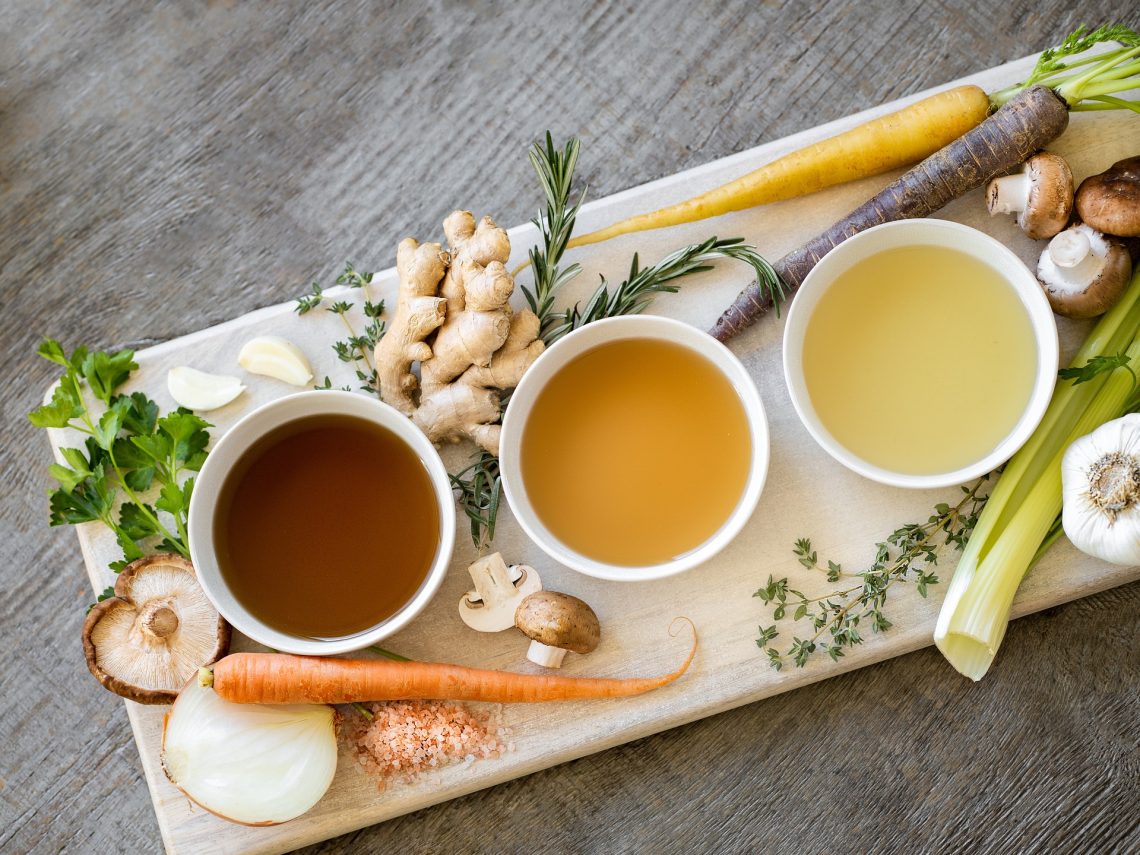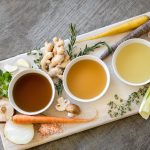
How to Make Bone Broth | Easy and Delicious
A South American Proverb says “Good broth will resurrect the dead” and – while we all know that’s not possible without Jesus – it can surely do the body good, in good times and bad. Broth has been a staple in homes since the beginning of time, being made from the bones of beef, chicken or fish, with optional veggies and herbs, it’s truly an economical, and delicious, way to stretch your budget and nourish your body.
Healing the Sick
What’s the first thing people bring to a sick person? Soup! Usually chicken noodle. I once knew an older woman who, every time when sick, would eat tons of Ramen Noodles (yes, the packet kind) – yuck! She “swore by” the chicken broth, hard to teach an old dog new tricks, and I wasn’t even going there with this one! Real, authentic broth is full of Gelatin, Calcium, Magnesium, Phosphorus, Silicon, Sulphur and trace minerals. It contains naturally occurring chondroitin sulphates and glucosamine – both which are now sold as pricy, lab-synthesized supplements, eagerly bought up by those suffering from arthritis and joint pain. If they only knew?
Gelatin
Gelatin deserves a block of it’s own. Nowadays, say the word Gelatin and for most people the brightly colored, overly sweetened, jiggly commercially sold dessert comes to mind, but that is so far from what gelatin longs to be in your life. Gelatin was studied immensely in France some 200 years ago, where they understood the richness and value of this glorious food, feeding it to their armies, the poor and the homeless to stretch food when meat and vegetables were difficult – or impossible – to acquire. Gelatin has been used to treat digestion issues, ulcers, diabetes, tuberculosis, muscle issues, jaundice and even cancer.
What’s Inside?
All good stock begins with bones. Sure, you can buy bouillon, add some water and viola – but you’re selling yourself short, sis – more than you know. Even bouillon labeled organic can be hiding a dirty little secret. Purchasing bone-in meat such as larger cuts of beef and lamb, and whole chickens allows you to utilize the entire animal, nothing goes to waste. Nowadays it’s common for people to seek out boneless, skinless chicken, already sliced and diced to your liking, just in the name of saving some time, but is the trade-off truly worth it? I say nay! Learn how to properly butcher – or break down – a chicken and you’ll have a valuable skill that will serve you and generations to come tenfold.
The Process
Grandma might not have had a Ph. D or any fancy letters preceding her name, but she knew what was up.
Browning your beef or lamb bones in the oven slightly, before making broth improves the color and the flavor of the final product.
You also want to add a splash of Vinegar, which helps extract calcium from the bones more efficiently.
Cold, filtered water is best, because slow heating helps bring out the flavors.
You don’t need nor want a vigorous boil – just a simmer will do.
Make sure to “skim” the surface in the first hour or so, as impurities and undesirables will rise to the surface and create small bubbly patches.
*You can, and are encouraged to, include additions such as vegetables and herbs (Parsley needs to be near the end of cooking time) to enhance nutrition and flavoring Bone Broth.
Timing
Depending on the type of bones you are using, you’ll want to adjust your time accordingly. Everyone has their own school of thought here, but the general consensus is:
- Fish: 2-12 hours
- Chicken: 6-12 hours
- Beef/Lamb/Red Game Meat: 12-72 hours
Of course, you’ll strain your broth once finished, and are encouraged to pick off the meat to utilize in casseroles, soups or tacos – however the texture will be quite mushy and the meat won’t be as nutritious due to much of it’s goodness being absorbed by your beautiful broth.
At this point, you may continue to cook down your broth, concentrating it for easier storage, you would just add filtered water back in once you’re ready to cook with it or drink it.
Chilling your broth (either in a large vessel, or in smaller jars, is ideal before freezing or storing, as the fat will rise to the surface and can be scooped off more easily. Don’t toss the fat, you can render it down a bit and use it for cooking – waste not, want not! It’s both beneficial and delicious!
Optional Add-ins
You may want to consider adding some or all of the following, to greatly enhance the mineral content, digestibility & flavor of your broths:
Vegetables & herbs – remember, Parsley is one that you want to add in the last 10 minutes of simmering. Parsley provides additional mineral ions to your broth.
Category Specific add-ins
Fish
Make sure you use the heads as well as the carcasses! The heads are rich in iodine and fat-soluble vitamins, which will greatly enhance the nutrient content of your broth.
Chicken
Chicken feet – this will add extra gelatin to your broth, increasing the nutrient content, flavor and also the thickness of the finished product.
You can also add the Gizzard if you are able to acquire it, gizzards are extremely nutrient dense – offering more B12 than red meat per ounce and also providing phosphorus, iron, zinc, copper, selenium, choline and good cholesterol! Wowzer!
Beef
Calves Foot; Knuckle, Rib and Neck Bones – these have become harder to find, even grocers who typically carry organ meats & chicken feet don’t usually stock these parts. However, you may have luck at specialty butchers or local farms (which is where you want to be purchasing your meat and bones ideally, anyway). Ask if they can process the feet into 1″ cubes, which will make them much easier to break down and assimilate into your stock.
Let’s Get Cookin’
So, you now should have a basic understanding of Why Bone Broth, and also the general How’s as well. I’m going to give you the recipes I use, which I originally pulled from Weston A. Price website, Nourishing Traditions book & modified from a conglomerate of texts and sources over the years. Feel free to experiment, because once you have the basics down you should totally make it your own!
Fish Stock
Ingredients
- 3-4 Whole Fish Carcasses (including heads) non-oily fish such as Snapper, Sole or Rockfish
- 2 Tbsp Butter
- 1 Large Onion Chopped
- 1 Carrot Chopped
- 1 Bay Leaf
- Fresh Thyme
- Fresh Parsley
- 1/2 C Dry White Cooking Wine
- Splash Vinegar Apple Cider or White
Instructions
- Melt butter in large stock pot
- Add veggies, sauté 30 mins
- Add wine & stir, deglazing until liquid is reduced by half
- Add vinegar, fish carcasses/heads & cold water
- Bring to a vigorous simmer, skimming any impurities as they rise
- Add Thyme or any other desired fresh herbs (hold off on the Parsley until the last 10 mins)
- Cover & Simmer for 2-24 hours
- Strain broth into jars & transfer to refrigerator
- Remove any fat that rises to the top, use within 24 hours or freeze
Chicken Stock | Bone Broth
Ingredients
- 2-3 lbs Chicken Carcass Free-Range, Pastured ideally (1-2 chickens)
- 2-4 Chicken Feet optional
- Gizzard from 1 chicken optional
- 1 Gallon Cold, filtered water
- Splash Vinegar Apple Cider or White
- 1 Large Onion chopped
- 2-3 Carrots chopped
- 2-3 Celery Stalks chopped
- Herbs Thyme, Rosemary, Parsley
Instructions
- Add Chicken carcass, vegetables & herbs (except Parsley), vinegar & cold water to a large stock pot & let sit one hour
- Bring to a boil slowly, skimming off any impurities that rise
- Reduce to low, cover and let simmer for 6-12 hours
- 10 minutes before finishing, add Parsley
- Strain the stock into a large container (or individual jars) and refrigerate until cold (you can salvage the meat and use it in tacos, soup or casseroles if you wish)
- Remove the layer of fat that has risen to the top & save*
- Store Chicken Stock in quart jars in the refrigerator for up to 48 hours or freeze
Notes
Beef Stock | Beef Bone Broth
Ingredients
- 3-4 lbs Beef Bones from various cuts
- 1 Calves Foot (cut into 1" cubes) optional
- 1 Gallon Cold, Filtered water you may need to add more as it simmers
- 1/4 c Vinegar Apple Cider or White
- 3 Onions chopped
- 3 Carrots chopped
- 3 Celery Stalks chopped
- Fresh Herbs Thyme, Rosemary, Parsley
- Peppercorns Whole or Crushed
Instructions
- Place Beef Bones on a large Roasting Pan & bake at 350F for 30-45 minutes until they start to brown
- Remove Beef Bones (scraping up any goodies left behind, also) and add to a large stock pot along with optional Calves Foot, vegetables, vinegar & cold water
- Let stand one hour
- Slowly bring to a vigorous simmer, skimming off any impurities that rise to the surface
- Reduce heat and add Herbs (except Parsley) and Peppercorns
- Simmer for at least 12 hours or as long as 72 hours (the longer the better – improved flavor and nutrient content)
- 10 minutes before finishing add the Parsley
- Strain into a large vessel or individual jars
- Transfer to refrigerator and let cool
- Remove fat from the top and save*
- Refrigerate stock for 24-48 hours or freeze
Notes






